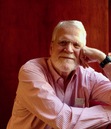Mark Scott Smith's Blog: Enemy in the Mirror, page 55
August 6, 2020
Operation Ripper – Fourth Battle of Seoul
With the UN Operation Ripper in March 1951, Seoul changed hands for the 4th time.
Following the 8-day, late February offensive of Operation Killer that pushed PVA/KPA forces north of the Han River, Operation Ripper was intended to destroy the Chinese People’s Volunteer Army and the Korean People’s Army forces around Seoul and the towns of Hongch’on and Chuncheon.

Conceived by General Matthew Ridgway, Operation Ripper aimed to bring UN troops to the 38th Parallel.
 Courtesy of the United States Military Academy Department of History
Courtesy of the United States Military Academy Department of HistoryThe post Operation Ripper – Fourth Battle of Seoul appeared first on Enemy in the Mirror.
August 3, 2020
Kefauver Senate Crime Investigation
In 1951 the United States Senate Special Committee to Investigate Crime in Interstate Commerce (Chairman -Senator Estes Kefauver) investigated inter-state organized crime.
“The Kefauver Committee hearings in the winter of 1951 brought a parade of gamblers, hoodlums, crooked sheriffs and organized-crime figures out from the shadows to sit and testify before the white-hot lights and television cameras… Colorful criminals, sweating and tapping their fingers nervously, seemed to step off the set of Hollywood gangster movies, speaking in broken English, under oath, about their activities. Some just sat in stony silence, refusing, as one witness said, to “criminate” themselves.” ~ Smithsonian Magazine
TV broadcasts of the hearings regarding municipal corruption and organized crime attracted public interest .
A fictionalized version of the Senate hearings appears in the 1974 film The Godfather Part II,
The post Kefauver Senate Crime Investigation appeared first on Enemy in the Mirror.
July 30, 2020
UN Forces Launch Major Counter-Offensive
On January 25, 1950, after a series of cautious reconnaissance advances, the U.S. 8th Army, under the command of Gen Matthew Ridgway, initiated Operation Thunderbolt, a major attack against Chinese and North Korean forces near the Han River.

The goal of Operation Thunderbolt was to inflict maximum punishment on the enemy while keeping major UN units intact.
GEN Ridgway stressed “good footwork combined with firepower.” 8th Army forces did not advance beyond carefully planned “phase lines” until every assigned unit reached it.
After Operation Thunderbolt secured the southern bank of the Han River, the Chinese and North Korean forces moved their operations further east.
In an attempt to regain the initiative, the Chinese counterattacked at the Battle of Hoengsong on February 11, briefly stopping US X Corps’ advance. However, without rest and recuperation, the new Communist offensive faded at the Battle of Chipyong-ni on February 15.

On February 21, 1950, with Communist forces incapable of further offensive operations, GEN Ridgway ordered Operation Killer to eliminate the remainder of Chinese and North Korean forces in the area.
The post UN Forces Launch Major Counter-Offensive appeared first on Enemy in the Mirror.
July 27, 2020
Korean War Movies 1951
American Korean War films released in 1951
The Korean War was the first armed, global conflict in the Cold War between Democratic and Communist states.
>5 million American troops fought in the war with >33,000 combat deaths and 92,000 injuries.
In 1953, the war ended in an uneasy truce along the 38th parallel on the Korean Peninsula.
 Wikimedia Commons
Wikimedia CommonsNevertheless, aside from M*A*S*H and a few books and films, the Korean War remains somehow “forgotten” in American culture when compared with literature and films about WWII, the war in Vietnam, and the wars in Iraq and Afghanistan. ~ USATODAY
The post Korean War Movies 1951 appeared first on Enemy in the Mirror.
July 23, 2020
General Mathew Ridgway assumes command of 8th Army
After General Walton “Johnnie” Walker, the commander of the US 8th Army in Korea, died in a jeep accident in December 1950, he was replaced by General Matthew Ridgway.
General Ridgway was a seasoned veteran of WWII where he commanded the 82nd Airborne Division through campaigns in Sicily, Italy and Normandy.

Known for his uncanny memory of faces and ability to relate to his men, Ridgway often stopped to praise soldiers in the lower ranks for their performance. At the same time, Ridgway was ruthless in relieving any officer who did not meet his high standards for battlefield performance.
Ridgway was also known to enjoy taunting the enemy by bold behaviors such as standing in the middle of a road to urinate amidst heavy German artillery fire to display contempt for their accuracy.
To exemplify his battle readiness in the field, Ridgway always wore a hand grenade and first aid kit attached to his paratrooper’s shoulder harness.
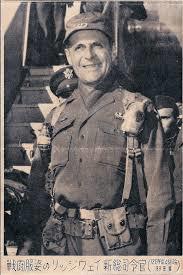
When Ridgway took over command of the 8th Army that was retreating before the Chinese onslaught, morale was dismal and “bugout fever” was endemic. Ridgway immediately began to restore the 8th Army’s will to fight.
He cabled the Pentagon asking for permission to replace almost every division commander and artillery commander in the Korean theater. After considerable political consternation in Washington. Ridgway eventually was able to send ineffective officers home as part of a “rotation policy.”
Ridgway demanded warmer clothing for his troops, stationery to write letters home, and hot meals complete with steak and chicken.
On New Year’s Eve, the Chinese and North Koreans smashed through the center of Ridgway’s battle line with an all-out assault.
 History army.mil
History army.milBy January 2, 1951 Ridgway realized the 8th Army would have to abandon Seoul and move to defensive positions south of the Han River. On the wall of his abandoned headquarters he left this message: To the commanding general of Communist Chinese forces with compliments from the commander of the 8th Army.
South of the Han, the 8th Army settled into their newly-constructed elaborate defenses and waited for the Chinese attack.
Source: Historynet
The post General Mathew Ridgway assumes command of 8th Army appeared first on Enemy in the Mirror.
July 20, 2020
Seoul City Sue – North Korean Propagandist
Anna Wallis Suh (1900–1969), nicknamed “Seoul City Sue,” was a Methodist missionary, educator, and North Korean propaganda radio announcer broadcasting to United States forces during the Korean War.
After joining the Shanghai American School (SAS) in 1938, Suh married fellow staff member Sŏ Kyu Ch’ŏl, thus losing her United States citizenship.
Late in WWII she was interned by the Japanese near Shanghai. After release, she resumed work at SAS for a year, before returning to Korea to teach school with her husband in 1946.
In 1949 Suh was fired from the U.S. Legation school in Seoul due to suspicions regarding her husband’s left-wing political activities.
The Suhs remained in Seoul during the North Korean Army’s invasion of South Korea in June 1950. In July 1950 Anna Wallis Suh began announcing an English language program for North Korean “Radio Seoul.”
After the Incheon landing in September 1950, the Suhs were evacuated north as a part of the general withdrawal of North Korean forces.
Suh then continued her broadcasts on Radio Pyongyang. The Suhs also participated in the political indoctrination of US POWs at a camp near Pyongyang in February 1951.
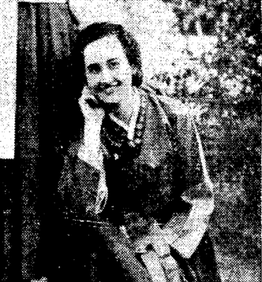 Wikipedia
WikipediaAfter the war, Suh was put in charge of English language publications for the Korean Central News Agency.
In 1972 Charles Jenkins, an American deserter reported that Anna Suh had been shot as a South Korean double agent in 1969.
The post Seoul City Sue – North Korean Propagandist appeared first on Enemy in the Mirror.
July 16, 2020
U.S. Bombing of Pyongyang
The first intentional U.S. air raid on civilian populations in North Korea occurred with the bombing of the capital city Pyongyang in January 1951. (YouTube video is from 1952).
Throughout the remainder of the war, a sustained U.S. air campaign targeted Pyongyang and other major cities of North Korea.
After running low on urban targets, U.S. bombers destroyed hydroelectric and irrigation dams in the later stages of the war, flooding farmland and destroying crops.
Source: Bombing of Pyongyang – Wikipedia
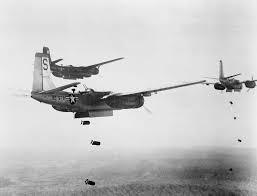 Wikipedia
Wikipedia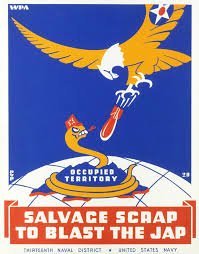 Wikipedia
WikipediaThe U.S. dropped more bombs on North Korea than on Japanese targets in the entire Pacific theater during WWII.
Whole cities were destroyed, with many thousands of innocent civilians killed and many more left homeless and hungry.
Carpet bombing during the Korean War included 32,000 tons of napalm, often deliberately targeting civilians as well as military targets.
 Wikimedia Commons
Wikimedia Commons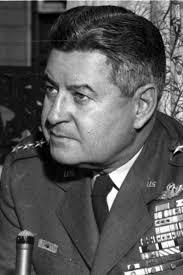 Gen. Curtis E. LeMay. (U.S. Air Force photo)
Gen. Curtis E. LeMay. (U.S. Air Force photo)“Over a period of three years or so, we killed off — what — 20 percent of the population,” Air Force Gen. Curtis LeMay, head of the Strategic Air Command during the Korean War, told the Office of Air Force History in 1984.
Source: Vox
The post U.S. Bombing of Pyongyang appeared first on Enemy in the Mirror.
July 13, 2020
U.S. , Chinese and North Korean Winter Uniforms

This Chinese soldier fighting in Korea 1950/53 is equipped with a Chinese Type 88 Hangyang rifle and wears a fur cap, the rice bag on his right side and bandoliers over his shoulders. Note also the cheap footwear and old-style leg wrappings.

North Korean infantryman with a Soviet 7.62mm PPSh sub-machine gun. He is wearing a winter uniform of quilted jacket, over trousers and a cap with ear flaps. North Korean equipment was basic but functional and showed a close link to Soviet gear which was better quality than Chinese.
The post U.S. , Chinese and North Korean Winter Uniforms appeared first on Enemy in the Mirror.
July 9, 2020
Korean War Comic Books
Following the sudden onset of hostilities in June 1950, the Korean War became the focus of a number of comic books.
Source: Advancing in another Direction
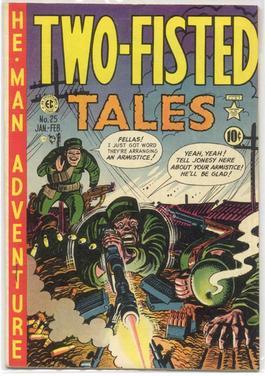
Beginning in 1951, E-C Comic’s Two-Fisted Tales followed the United States into the Korean war.
Two-Fisted Tales
A few examples of Korean War Comic books




The post Korean War Comic Books appeared first on Enemy in the Mirror.
July 6, 2020
1950 ~ Cold War Turns Hot in Korea
In the summer of 1950 the Soviet-equipped North Korean People’s army (NKPA) steamrollered over the 38th parallel into South Korea.
Overwhelming South Korean and American forces the NKPA advanced rapidly south to the Busan perimeter where they almost pushed the defenders into the sea.
In the fall, the tide turned with the landing of UN troops at Incheon, essentially cutting supply lines and trapping the NKPA between two UN forces. The NKPA went into full retreat.
By Thanksgiving, UN forces had advanced to the Yalu River on the border between North Korea and Manchuria.
Then came a massive Communist Chinese attack that forced UN forces south once again.
By year’s end, the war was raging around the 38th parallel.
This silent clip illustrates the misery of war in the Korean winter.
The post 1950 ~ Cold War Turns Hot in Korea appeared first on Enemy in the Mirror.
Enemy in the Mirror
I began by posting events around the turn This website www.enemyinmirror.com explores the consciousness, diplomacy, emotion, prejudice and psychology of 20th Century America and her enemies in wartime.
I began by posting events around the turn of the 20th century as I was researching my first novel about the Pacific War. I continued through WWII for my second novel about the Battle of the Atlantic. Now I am beginning to look at the Cold War as I gather information for my next novel about the Korean War. ...more
- Mark Scott Smith's profile
- 7 followers


